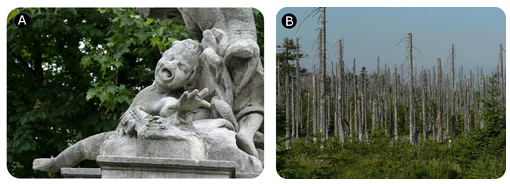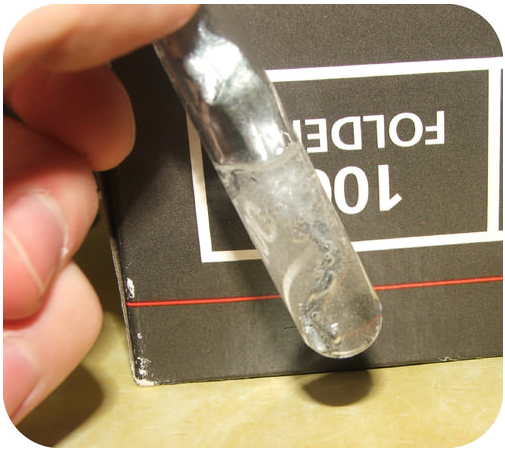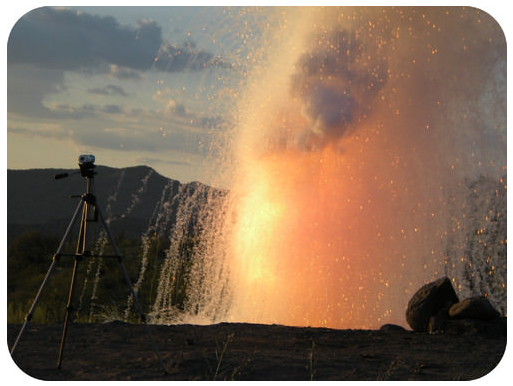Part a Review the Following Are Descriptions of the Types of Chemical Reactions
7.10: Classifying Chemical Reactions
- Folio ID
- 47512
Learning Objectives
- Classify a chemical reaction as a synthesis, decomposition, single replacement, double replacement, or a combustion reaction.
- Predict the products of simple reactions.
The chemic reactions we have described are only a tiny sampling of the infinite number of chemic reactions possible. How do chemists cope with this overwhelming multifariousness? How do they predict which compounds will react with i another and what products will exist formed? The primal to success is to notice useful ways to categorize reactions. Familiarity with a few basic types of reactions will help y'all to predict the products that form when certain kinds of compounds or elements come in contact.
Most chemical reactions tin be classified into one or more of 5 basic types: acrid–base reactions, exchange reactions, condensation reactions (and the reverse, cleavage reactions), and oxidation–reduction reactions. The general forms of these five kinds of reactions are summarized in Table \(\PageIndex{1}\), along with examples of each. It is of import to note, withal, that many reactions can be assigned to more than one classification, equally yous volition see in our give-and-take.
| Proper noun of Reaction | General Form | Examples |
|---|---|---|
| Oxidation–Reduction (redox) | oxidant + reductant → reduced oxidant + oxidized reductant | C7H16(50) + 11Oii(1000) → 7CO2(g) + 8HtwoO(g) |
| Acid–Base | acid + base of operations → salt | NaOH(aq) + HNO3(aq) → NaNO3(aq) +H2O(l) |
| Commutation: Single Replacement | AB + C → AC + B | ZnCl2(aq)+ Mg(s) → MgCl2(aq)+ Zn(s) |
| Exchange: Double Replacement | AB + CD → AD + CB | BaCl2(aq) + Na2And then4(aq) → BaSO4(southward) + 2NaCl(aq) |
| Combination (Synthesis) | A + B → AB | COii(g) + H2O(l) → H2CO3(aq) North2(g) + 2Otwo(chiliad)→ 2NO2(g) |
| Decomposition | AB → A + B | CaCOthree(s) → CaO(s) + CO2(g) |
The classification scheme is only for convenience; the same reaction can be classified in different ways, depending on which of its characteristics is most important. Oxidation–reduction reactions, in which at that place is a net transfer of electrons from one atom to another, and condensation reactions are discussed in this section. Acid–base reactions are one kind of exchange reaction—the germination of an insoluble common salt, such equally barium sulfate, when solutions of two soluble salts are mixed together.
Combination Reactions
A combination reaction is a reaction in which two or more substances combine to grade a single new substance. Combination reactions can also be called synthesis reactions. The general form of a combination reaction is:
\[\ce{A} + \ce{B} \rightarrow \ce{AB}\]
1 combination reaction is two elements combining to form a chemical compound. Solid sodium metal reacts with chlorine gas to produce solid sodium chloride.
\[2 \ce{Na} \left( south \right) + \ce{Cl_2} \left( g \right) \rightarrow 2 \ce{NaCl} \left( s \right) \nonumber \]
Notice that in order to write and balance the equation correctly, it is important to recollect the 7 elements that be in nature as diatomic molecules (\(\ce{H_2}\), \(\ce{N_2}\), \(\ce{O_2}\), \(\ce{F_2}\), \(\ce{Cl_2}\), \(\ce{Br_2}\), and \(\ce{I_2}\)).
One type of combination reaction that occurs frequently is the reaction of an element with oxygen to form an oxide. Metals and nonmetals both react readily with oxygen nether nearly conditions. Magnesium reacts chop-chop and dramatically when ignited, combining with oxygen from the air to produce a fine powder of magnesium oxide:
\[2 \ce{Mg} \left( s \right) + \ce{O_2} \left( g \right) \rightarrow 2 \ce{MgO} \left( south \right) \nonumber \]
Sulfur reacts with oxygen to grade sulfur dioxide:
\[\ce{S} \left( southward \correct) + \ce{O_2} \left( chiliad \right) \rightarrow \ce{SO_2} \left( g \right) \nonumber \]
When nonmetals react with one another, the product is a molecular compound. Often, the nonmetal reactants can combine in dissimilar ratios and produce dissimilar products. Sulfur tin too combine with oxygen to form sulfur trioxide:
\[two \ce{Due south} \left( s \right) + 3 \ce{O_2} \left( g \right) \rightarrow ii \ce{SO_3} \left( g \right) \nonumber \]
Transition metals are capable of adopting multiple positive charges inside their ionic compounds. Therefore, about transition metals are capable of forming different products in a combination reaction. Atomic number 26 reacts with oxygen to form both iron (2) oxide and iron (Three) oxide:
\[ii \ce{Iron} \left( s \correct) + \ce{O_2} \left( g \right) \rightarrow two \ce{FeO} \left( s \right) \nonumber \]
\[4 \ce{Fe} \left( s \right) + 3 \ce{O_2} \left( g \right) \rightarrow 2 \ce{Fe_2O_3} \left( s \right) \nonumber \]
Example \(\PageIndex{1}\): Combustion of Solid Potassium
Potassium is a very reactive brine metal that must be stored under oil in order to foreclose it from reacting with air. Write the balanced chemic equation for the combination reaction of potassium with oxygen.
Solution
| Steps | Case Solution |
|---|---|
| Plan the problem. | Make certain formulas of all reactants and products are correct before balancing the equation. Oxygen gas is a diatomic molecule. Potassium oxide is an ionic compound and and so its formula is constructed by the crisscross method. Potassium every bit an ion becomes \(\ce{Thou^+}\), while the oxide ion is \(\ce{O^{two-}}\). |
| Solve. | The skeleton (unbalanced) equation: \[\ce{K} \left( s \correct) + \ce{O_2} \left( g \right) \rightarrow \ce{K_2O} \left( s \right) \nonumber\] The equation is so easily counterbalanced with coefficients. \[4 \ce{Yard} \left( southward \right) + \ce{O_2} \left( g \right) \rightarrow 2 \ce{K_2O} \left( s \right) \nonumber\] |
| Call back about your outcome. | Formulas are correct and the resulting combination reaction is counterbalanced. |
Combination reactions can too take place when an element reacts with a compound to form a new chemical compound equanimous of a larger number of atoms. Carbon monoxide reacts with oxygen to form carbon dioxide according to the equation:
\[2 \ce{CO} \left( g \right) + \ce{O_2} \left( g \correct) \rightarrow 2 \ce{CO_2} \left( g \right)\]
Two compounds may also react to grade a more complex compound. A very mutual example is the reactions of oxides with h2o. Calcium oxide reacts readily with water to produce an aqueous solution of calcium hydroxide:
\[\ce{CaO} \left( southward \correct) + \ce{H_2O} \left( l \correct) \rightarrow \ce{Ca(OH)_2} \left( aq \correct)\]
Sulfur trioxide gas reacts with water to form sulfuric acid. This is an unfortunately mutual reaction that occurs in the temper in some places where oxides of sulfur are present equally pollutants. The acid formed in the reaction falls to the basis as acid rain.
\[\ce{SO_3} \left( g \right) + \ce{H_2O} \left( fifty \right) \rightarrow \ce{H_2SO_4} \left( aq \correct)\]

Exercise \(\PageIndex{1}\)
- Write the chemical equation for the synthesis of silver bromide, \(\ce{AgBr}\).
- Predict the products for the following reaction: \(\ce{CO_2} \left( thou \right) + \ce{H_2O} \left( l \right)\)
- Answer a:
- \(2 \ce{Ag} + \ce{Br_2} \rightarrow 2 \ce{AgBr}\)
- Respond b:
- \(\ce{CO_2} \left( grand \right) + \ce{H_2O} \left( fifty \correct) \rightarrow \ce{H_2CO_3}\)
Decomposition Reactions
A decomposition reaction is a reaction in which a compound breaks down into two or more simpler substances. The general form of a decomposition reaction is:
\[\ce{AB} \rightarrow \ce{A} + \ce{B}\]
Most decomposition reactions crave an input of energy in the class of oestrus, low-cal, or electricity.
Binary compounds are compounds composed of merely two elements. The simplest kind of decomposition reaction is when a binary chemical compound decomposes into its elements. Mercury (II) oxide, a red solid, decomposes when heated to produce mercury and oxygen gas:
\[2 \ce{HgO} \left( s \right) \rightarrow ii \ce{Hg} \left( fifty \right) + \ce{O_2} \left( g \right)\]
Video \(\PageIndex{two}\): Mercury (II) oxide is a ruby solid. When it is heated, it decomposes into mercury metal and oxygen gas.
A reaction is also considered to be a decomposition reaction even when one or more of the products are even so compounds. A metal carbonate decomposes into a metal oxide and carbon dioxide gas. For example, calcium carbonate decomposes into calcium oxide and carbon dioxide:
\[\ce{CaCO_3} \left( s \right) \rightarrow \ce{CaO} \left( s \correct) + \ce{CO_2} \left( g \correct)\]
Metal hydroxides decompose on heating to yield metal oxides and water. Sodium hydroxide decomposes to produce sodium oxide and water:
\[2 \ce{NaOH} \left( southward \right) \rightarrow \ce{Na_2O} \left( south \correct) + \ce{H_2O} \left( g \right)\]
Some unstable acids decompose to produce nonmetal oxides and water. Carbonic acid decomposes easily at room temperature into carbon dioxide and water:
\[\ce{H_2CO_3} \left( aq \right) \rightarrow \ce{CO_2} \left( g \correct) + \ce{H_2O} \left( 50 \right)\]
Example \(\PageIndex{2}\): Electrolysis of Water
When an electric current is passed through pure water, it decomposes into its elements. Write a balanced equation for the decomposition of water.
Solution
| Steps | Example Solution |
|---|---|
| Programme the problem. | Water is a binary compound composed of hydrogen and oxygen. The hydrogen and oxygen gases produced in the reaction are both diatomic molecules. |
| Solve. | The skeleton (unbalanced) equation: \[\ce{H_2O} \left( fifty \right) \overset{\text{elec}}{\rightarrow} \ce{H_2} \left( k \right) + \ce{O_2} \left( g \right) \nonumber\] Annotation the abbreviation "\(\text{elec}\)" above the pointer to indicate the passage of an electric current to initiate the reaction. Balance the equation. \[2 \ce{H_2O} \left( l \right) \overset{\text{elec}}{\rightarrow} two \ce{H_2} \left( 1000 \right) + \ce{O_2} \left( thou \right) \nonumber\] |
| Think about your result. | The products are elements and the equation is balanced. |
Exercise \(\PageIndex{two}\)
Write the chemical equation for the decomposition of:
- \(\ce{Al_2O_3}\)
- \(\ce{Ag_2S}\)
- Answer a
- \(2 \ce{Al_2O_3} \rightarrow 4 \ce{Al} + three \ce{O_2}\)
- Reply b
- \(\ce{Ag_2S} \rightarrow two \ce{Ag} + \ce{S}\)
Single Replacement Reactions
A third type of reaction is the unmarried replacement reaction, in which one chemical element replaces a similar chemical element in a compound. The general course of a single-replacement (also called single-displacement) reaction is:
\[\ce{A} + \ce{BC} \rightarrow \ce{Ac} + \ce{B}\]
In this general reaction, chemical element \(\ce{A}\) is a metal and replaces element \(\ce{B}\), as well a metallic, in the chemical compound. When the chemical element that is doing the replacing is a nonmetal, it must replace another nonmetal in a compound, and the general equation becomes:
\[\ce{Y} + \ce{XZ} \rightarrow \ce{XY} + \ce{Z}\]
where \(\ce{Y}\) is a nonmetal and replaces the nonmetal \(\ce{Z}\) in the compound with \(\ce{X}\).
Metal Replacement
Magnesium is a more reactive metal than copper. When a strip of magnesium metal is placed in an aqueous solution of copper (II) nitrate, information technology replaces the copper. The products of the reaction are aqueous magnesium nitrate and solid copper metallic.
\[\ce{Mg} \left( s \correct) + \ce{Cu(NO_3)_2} \left( aq \right) \rightarrow \ce{Mg(NO_3)_2} \left( aq \right) + \ce{Cu} \left( south \right)\]
This subcategory of single-replacement reactions is called a metal replacement reaction because it is a metal that is being replaced (copper).
Hydrogen Replacement
Many metals react hands with acids and when they do so, one of the products of the reaction is hydrogen gas. Zinc reacts with hydrochloric acid to produce aqueous zinc chloride and hydrogen (figure below).
\[\ce{Zn} \left( south \right) + 2 \ce{HCl} \left( aq \right) \rightarrow \ce{ZnCl_2} \left( aq \correct) + \ce{H_2} \left( g \right)\]
In a hydrogen replacement reaction, the hydrogen in the acid is replaced by an active metal. Some metals are so reactive that they are capable of replacing the hydrogen in water. The products of such a reaction are the metallic hydroxide and hydrogen gas. All Group ane metals undergo this blazon of reaction. Sodium reacts vigorously with water to produce aqueous sodium hydroxide and hydrogen (see figure below).
\[2 \ce{Na} \left( s \right) + two \ce{H_2O} \left( l \right) \rightarrow two \ce{NaOH} \left( aq \right) + \ce{H_2} \left( g \right)\]


Halogen Replacement
The element chlorine reacts with an aqueous solution of sodium bromide to produce aqueous sodium chloride and elemental bromine:
\[\ce{Cl_2} \left( g \right) + two \ce{NaBr} \left( aq \right) \rightarrow 2 \ce{NaCl} \left( aq \right) + \ce{Br_2} \left( l \right)\]
The reactivity of the element of group vii group (group 17) decreases from top to bottom within the group. Fluorine is the virtually reactive element of group vii, while iodine is the least. Since chlorine is higher up bromine, it is more reactive than bromine and can replace it in a element of group vii replacement reaction.
Example \(\PageIndex{3}\)
What are the products of the reaction betwixt solid aluminum (\(\ce{Al}\)) and iron (III) oxide (\(\ce{Fe_2O_3}\))?
Solution
| Steps | Example Solution |
|---|---|
| Plan the problem. | To predict the products, we need to know that aluminum will replace atomic number 26 and form aluminum oxide (the metal volition replace the metal ion in the compound). Aluminum has a charge of \(+3\) and oxygen has a charge of \(-2\). The compound formed between aluminum and oxygen, therefore, will be \(\ce{Al_2O_3}\). Since iron is replaced in the compound past aluminum, the iron volition now be the unmarried chemical element in the products. |
| Solve. | The unbalanced equation will be: \[\ce{Al} + \ce{Fe_2O_3} \rightarrow \ce{Al_2O_3} + \ce{Atomic number 26} \nonumber\] and the balanced equation will be: \[2 \ce{Al} + \ce{Fe_2O_3} \rightarrow \ce{Al_2O_3} + two \ce{Atomic number 26} \nonumber\] |
| Call back about your issue. | This is a single replacement reaction, and when counterbalanced the coefficients accurately reverberate that the iron and aluminum have the aforementioned accuse in this reaction. |
Exercise \(\PageIndex{3}\)
- Write the chemical equation for the unmarried replacement reaction betwixt zinc solid and pb (Ii) nitrate solution to produce zinc nitrate solution and solid lead. (Note that zinc forms ions with a \(+2\) charge.)
- Predict the products for the following reaction: \(\ce{Fe} + \ce{CuSO_4}\). (In this reaction, assume iron forms ions with a \(+2\) charge.)
- Respond a
- \(\ce{Zn} + \ce{Pb(NO_3)_2} \rightarrow \ce{Pb} + \ce{Zn(NO_3)_2}\)
- Answer b
- \(\ce{Iron} + \ce{CuSO_4} \rightarrow \ce{Cu} + \ce{FeSO_4}\)
Double Replacement Reactions
A double-replacement reaction is a reaction in which the positive and negative ions of 2 ionic compounds exchange places to grade two new compounds. The general form of a double-replacement (besides called double-displacement) reaction is:
\[\ce{AB} + \ce{CD} \rightarrow \ce{AD} + \ce{BC}\]
In this reaction, \(\ce{A}\) and \(\ce{C}\) are positively-charged cations, while \(\ce{B}\) and \(\ce{D}\) are negatively-charged anions. Double-replacement reactions generally occur between substances in aqueous solution. In order for a reaction to occur, 1 of the products is ordinarily a solid precipitate, a gas, or a molecular chemical compound such as water.
Germination of a Precipitate
A precipitate forms in a double-replacement reaction when the cations from one of the reactants combine with the anions from the other reactant to form an insoluble ionic compound. When aqueous solutions of potassium iodide and lead (Two) nitrate are mixed, the following reaction occurs:
\[2 \ce{KI} \left( aq \right) + \ce{Atomic number 82(NO_3)_2} \left( aq \right) \rightarrow 2 \ce{KNO_3} \left( aq \right) + \ce{PbI_2} \left( s \correct) \characterization{eq10}\]
There are very potent attractive forces that occur between \(\ce{Pb^{2+}}\) and \(\ce{I^-}\) ions and the result is a vivid yellow precipitate (Figure \(\PageIndex{3}\)). The other production of the reaction, potassium nitrate, remains soluble.
_iodide_precipitating_out_of_solution.jpg?revision=1&size=bestfit&width=194&height=240)
Formation of a Gas
Some double-replacement reactions produce a gaseous product which so bubbling out of the solution and escapes into the air. When solutions of sodium sulfide and hydrochloric acid are mixed, the products of the reaction are aqueous sodium chloride and hydrogen sulfide gas:
\[\ce{Na_2S} \left( aq \right) + 2 \ce{HCl} \left( aq \right) \rightarrow ii \ce{NaCl} \left( aq \correct) + \ce{H_2S} \left( yard \right)\]
Formation of a Molecular Compound
Another kind of double-replacement reaction is one that produces a molecular compound as ane of its products. Many examples in this category are reactions that produce water. When aqueous hydrochloric acid is reacted with aqueous sodium hydroxide, the products are aqueous sodium chloride and water:
\[\ce{HCl} \left( aq \right) + \ce{NaOH} \left( aq \correct) \rightarrow \ce{NaCl} \left( aq \right) + \ce{H_2O} \left( fifty \right)\]
Example \(\PageIndex{4}\)
Write a consummate and balanced chemical equation for the double-replacement reaction \(\ce{NaCN} \left( aq \right) + \ce{HBr} \left( aq \right) \rightarrow\) (hydrogen cyanide gas is formed).
Solution
| Steps | Example Solution |
|---|---|
| Program the trouble. | The product of a gas drives the reaction. |
| Solve. | The cations of both reactants are \(+1\) charged ions, while the anions are \(-1\) charged ions. After exchanging partners, the balanced equation is: \[\ce{NaCN} \left( aq \right) + \ce{HBr} \left( aq \right) \rightarrow \ce{NaBr} \left( aq \right) + \ce{HCN} \left( g \right)\] |
| Think nigh your result. | This is a double replacement reaction. All formulas are right and the equation is balanced. |
Exercise \(\PageIndex{4}\)
Write a complete and balanced chemical equation for the double-replacement reaction \(\ce{(NH_4)_2SO_4} \left( aq \right) + \ce{Ba(NO_3)_2} \left( aq \right) \rightarrow\) (a precipitate of barium sulfate forms).
- Answer a:
- \[\ce{(NH_4)_2SO_4} \left( aq \right) + \ce{Ba(NO_3)_2} \left( aq \correct) \rightarrow 2 \ce{NH_4NO_3} \left( aq \right) + \ce{BaSO_4} \left( s \right)\]
Occasionally, a reaction will produce both a gas and a molecular chemical compound. The reaction of a sodium carbonate solution with hydrochloric acid produces aqueous sodium chloride, carbon dioxide gas, and water:
\[\ce{Na_2CO_3} \left( aq \right) + 2 \ce{HCl} \left( aq \correct) \rightarrow 2 \ce{NaCl} \left( aq \right) + \ce{CO_2} \left( m \correct) + \ce{H_2O} \left( l \right) \nonumber\]
Contributions & Attributions
This folio was constructed from content via the following contributor(south) and edited (topically or extensively) by the LibreTexts development team to meet platform style, presentation, and quality:
-
Marisa Alviar-Agnew (Sacramento Metropolis College)
-
Henry Agnew (UC Davis)
Source: https://chem.libretexts.org/Bookshelves/Introductory_Chemistry/Map%3A_Introductory_Chemistry_(Tro)/07%3A_Chemical_Reactions/7.10%3A_Classifying_Chemical_Reactions
Publicar un comentario for "Part a Review the Following Are Descriptions of the Types of Chemical Reactions"